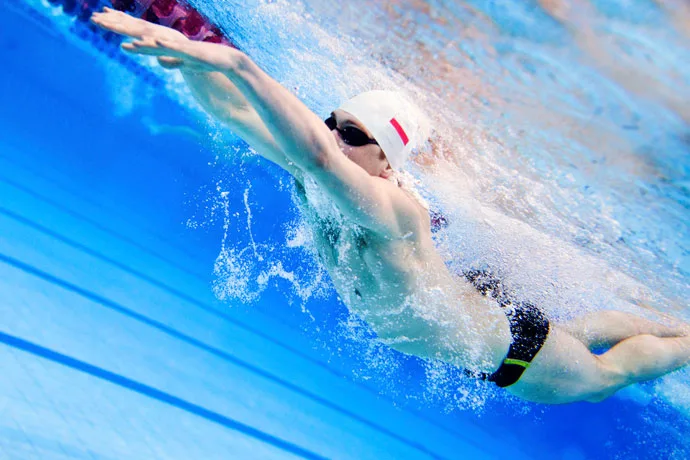An important component of a good butterfly swimming technique is body undulation. Seen from the side, the body performs a wave-like movement that begins at the head and ends at the feet.
Taking the time to learn this body undulation properly makes sense, as the dolphin kick and arm stroke often fall into place naturally once body undulation has been mastered.
This technique is explained in more detail below.

Body Movement
To explain how to create the undulating movements of the body, we will keep the arm stroke out of the picture for now. The arm stroke movements are explained in a separate article.
So let’s consider this starting position:
- The swimmer is floating in the water in a prone position.
- The head is in line with the trunk, and the face is in the water, eyes down.
- The arms are extended forward (or rest at the sides).
- The legs are straight and held together; the feet are extended.
To start the undulating movements of the body, the swimmer does the following:
- He pushes his chest down a few inches into the water, then releases it. The head follows along.
- As he releases his chest, he pushes his hips down into the water.
- Then he releases his hips and pushes his chest down again.
- And so on…
Pushing and releasing the chest and hips in sequence in this manner is what drives body undulation.
As a side note, it is commonly believed that the body undulation is mainly driven by the up and down movements of the hips. However, the vertical movements of the head and shoulders actually exceed those of the hips.[1]
Dolphin Kick
From the hips, the body undulation continues to move through the legs. So when the hips move down in the water, the upper legs follow while the knees bend.
Then, when the hips move up, the knees extend, and the feet kick downward and backward against the water with a whipping motion.
This simultaneous movement of the legs is called the dolphin kick and is covered in more detail here. Finally, the legs move up again, and a new body undulation cycle can start.
Head Movement
The movement of the head during body undulation is more subtle than a simple up and down movement:
- When the chest moves downward, the head should be tilted forward a little (as one would do when nodding).
- When the chest moves upward, the head should be tilted back a little (as one would do when looking upward).
To visualize this, when you push your chest down, imagine that you are trying to capture a bundle of water behind your neck. Then when you release your chest, try to let this bundle of water slide down your back.
Adding these head movements helps convert the body’s vertical up and down movements into propulsive movements.
However, these head movements should not be exaggerated (to not strain the neck).
It should also be noted that while swimming butterfly, there are breathing and non-breathing stroke cycles.
During a breathing stroke cycle, the entire upper body is lifted higher above the water’s surface with a strong kick, and not just the head.
The head movements should be fluid and well-integrated in the body undulation, and these head movements are pretty much the same during breathing and non-breathing stroke cycles.
Additional Tips
- It is generally believed that the butterfly stroke requires good flexibility in the back and shoulders. However, in my opinion, having a fluid body undulation along with good timing in performing the arm stroke and the kick is more important.
- Butterfly swimming is exhausting, and especially so with poor technique. So it’s worth investing some time practicing the body undulation and dolphin kick.
Reference
1. Maglischo, E. (2003). Swimming Fastest. Champaign, IL: Human Kinetics, p. 166.
Related Pages
You may also be interested in the following articles that cover the butterfly stroke’s swimming technique:
